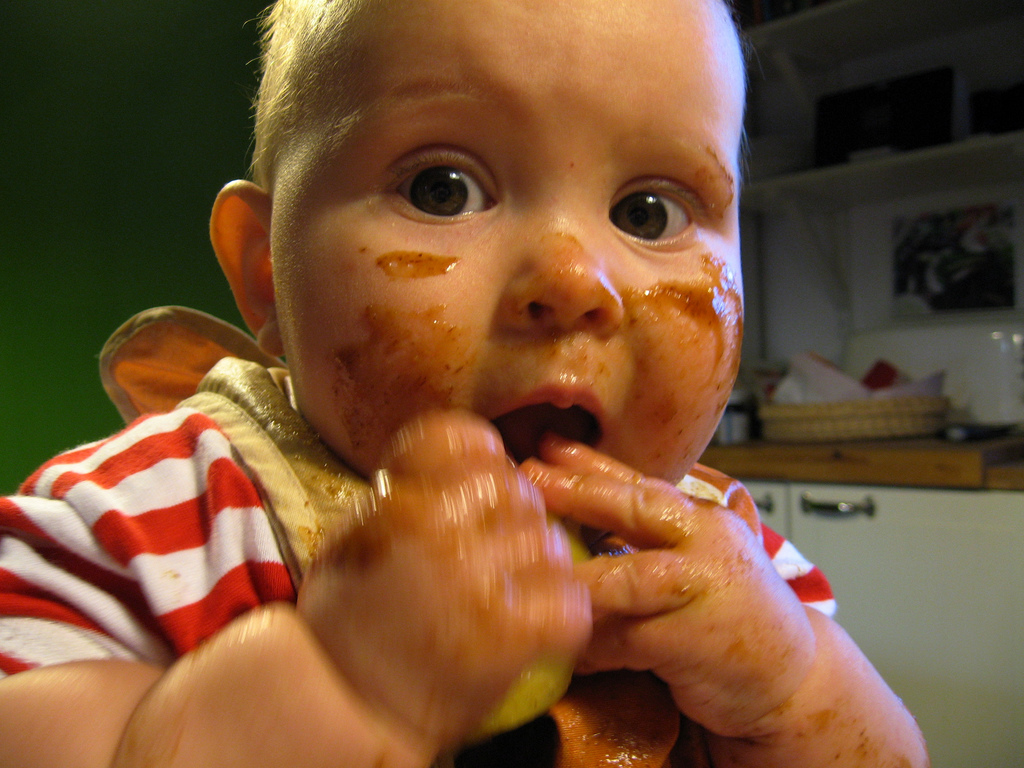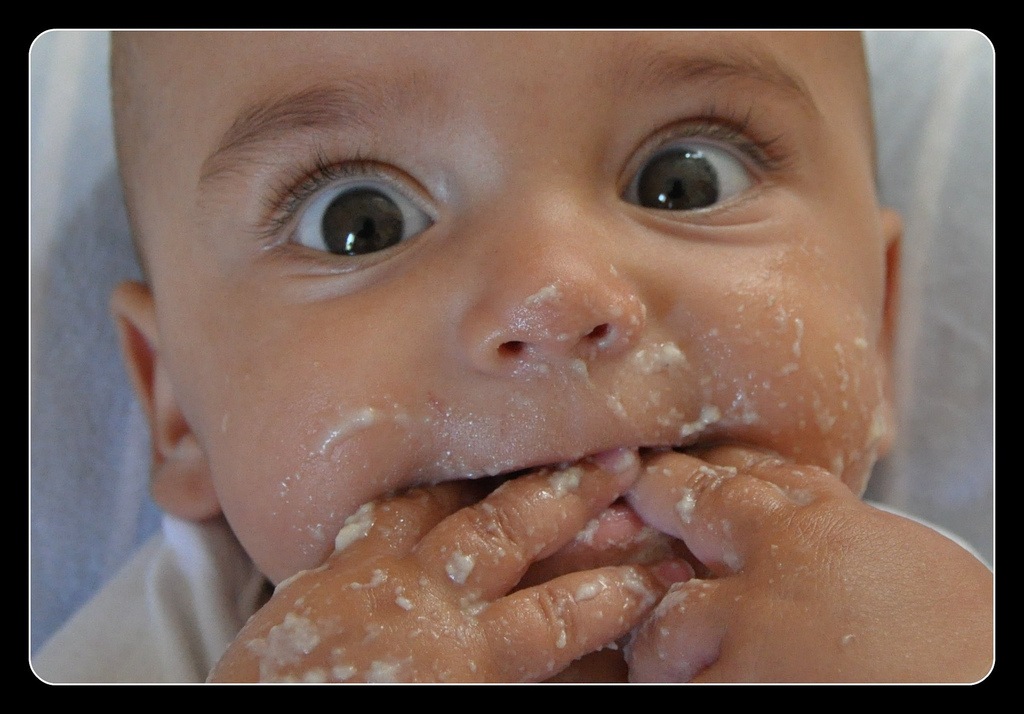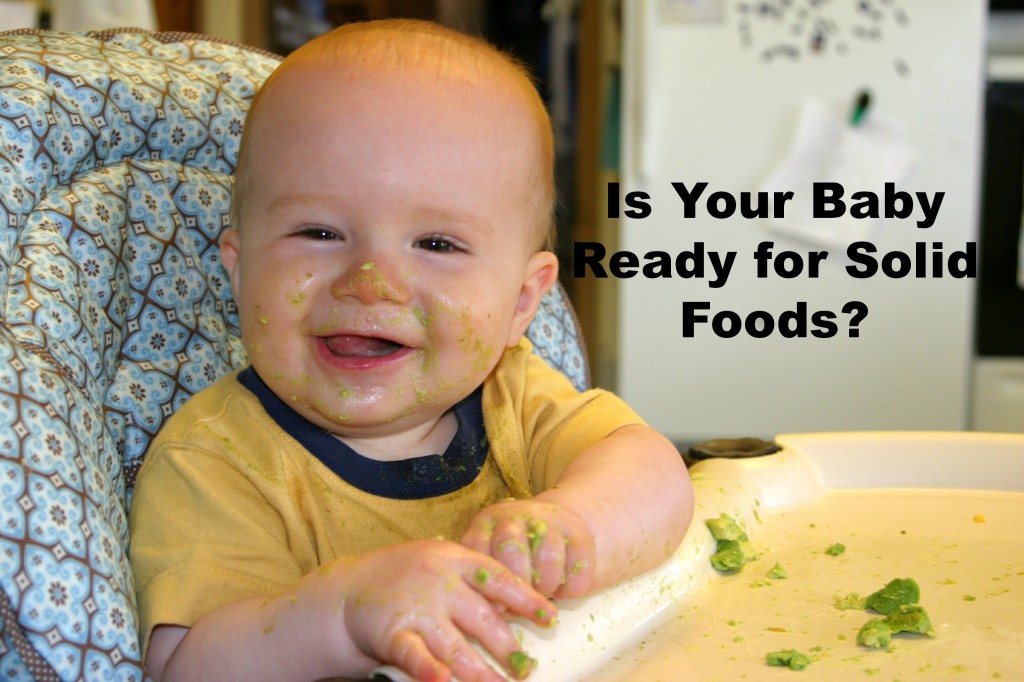Now that you have determined your baby is ready for solids and you have decided how you want to feed your child, the all important question of what to feed them becomes relevant.
In the recent past, iron fortified rice cereal was often the recommended first food for babies. This recommendation has started to come under question. Rice and other cereals are a heavily processed food with most of the nutrients stripped out. Rice cereal, in particular, has recently been called into question due to the presence of arsenic in some rice (AAP, 2003). There is also some question about a baby’s ability to digest grains due to a lack of pancreatic amylase, the enzyme needed to breakdown carbohydrates. A baby doesn’t have full pancreatic amylase production until the age of 28 months (Dessinger, 2011). However, breast milk is a rich source of alpha amylase, offering breastfed babies added digestive help (Lindberg, 1982). This amylase is unique because it has a broad range for pH tolerances. This broad range helps the amylase survive the low pH of the stomach and helps digest carbohydrates in the small intestine. Babies also have two other enzymes in their small intestines, sucrase-isomaltase and glucoamylase, which aid in the digestion of carbohydrates (Harrison, 2012).
One more factor to consider in the introduction of grains is the timing of adding them to your baby’s diet. In 2012, Norris et al conducted a study looking at the relationship between the time of first gluten exposure to the development of celiac disease. They found that babies fed barley, rye or wheat cereal in the first three months of life had a 5 fold increase in the development of celiac disease over children whose first exposure was between 4-6 months of age. Children who were not exposed to gluten until the seventh month, had a marginally higher rate of celiac then those children exposed between four and six months. A similar study looked at time of first wheat exposure and the development of a wheat allergy. Pool et al (2006) found similar results about the timing of first exposure. Both of these studies point to a sweet spot of four to six months of age for first time gluten exposure to decrease the risk of celiac disease or wheat allergy.
Adding grains to your infant’s diet will need to be a personal choice. If you do decide to introduce them at this time, do not make them the main component of your child’s meals. Vegetables, meat and fruits should be the main course with cereal as a small addition. Remember an infant’s stomach is only as big as his/her fist. Adjust your portion size accordingly. Avoid processed baby cereal. You can make your own cereal gruel with properly prepared, soaked and sprouted grains such as oats, spelt, rye or barley (Fallon, 2013). Sally Fallon is an excellent resource for properly preparing grains.
Good first foods for babies include avocado, green beans, squash, egg yolks, carrots, pumpkin, banana, bone broth, sweet potato, shaved organic liver, and pureed meats. Small amounts of unsweetened goat or sheep’s milk yogurt and fish eggs can also be good additions to an infant’s diet. If at all possible these foods should be organic and/or grass fed. Fruits and vegetables should be soft cooked and consist of only one ingredient. Introduce only one new food every few days so if your child has an allergic reaction you can pinpoint the culprit (Sears, 2013). If after a couple of days of eating a new food you see no reaction, then you can add another new food. Signs of an allergic reaction include:
- Hives or welts
- Flushed skin or hives
- Difficulty breathing
- Swollen tongue, face or cheeks
- Diarrhea and/or vomiting
- Loss of consciousness
- Coughing or wheezing
Allergic reactions can escalate quickly. If your child is having difficulty breathing, having severe diarrhea and/or vomiting or is experiencing swelling of the face or tongue, call 911 immediately.
Before sitting down to a meal of solid foods, allow your infant to breast-feed or bottle feed first so they are not starving when they sit down and become frustrated with getting the food to their mouths. As your child becomes more adept at eating solids, you can continue to introduce new tastes, textures and smells. The goal is to get your child to eat the same food you are eating. If your child refuses a food at first, reintroduce it at a later date. It often takes a baby multiple exposures to a particular food or texture before he/she likes it (Satter, 2000). Now is not the time to restrict healthy fat. Fat from fish, avocados, fish oil, breast milk and other healthy sources are necessary for brain development and vitamin absorption (Sears, 2013).
Foods to Avoid
- Hot dogs, nuts, hard candies and other choking hazards.
- Foods with added sugar.
- Cow’s dairy before 1 year of age. Sheep or goat’s milk unsweetened, cultured (like yogurt or kefir) dairy can be okay in moderation.
- Honey before 1 year of age.
- Common allergens such as nuts, wheat, citrus, corn and soy.
- Peanuts, egg whites and shellfish are also common allergens so care should be exercised in their introduction.
- Spinach and strawberries have been known to cause reactions in some infants.
- Care should be used when introducing fish due to the concern with contamination from mercury. White, small, middle swimming fish should be introduced first.
(For references see first article in the series.)
Photo by Sami Keinanen on Flickr under the Creative Commons license.
This post shared with Homespun Oasis and The Nourishing Gourmet.



